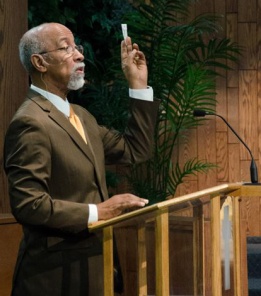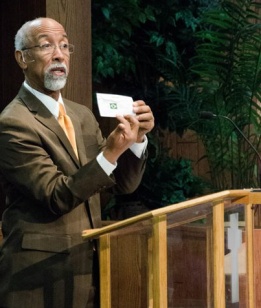“Then Boaz announced to the elders and all the people…” Ruth 4:9 (New International Version)
It’s the snarkiest of times, it’s the most troublesome of times. It’s time for the church announcements, the bane of a worship planner’s planning. What a to do!

You could mention them at the start of the Service of Worship, like the pre-show curtain speech in theater . But then, the people don’t hear them. They’re getting settled waiting for the real show to start: the music; the real worship, you know? Or for the music to stop. That could be another 10 minutes. More people would be in the audience to hear them. But then…?
If the announcements are in the middle of the service, either before or after the sermon, they interrupt the tone set up by the music to receive the message, or the reflect on it afterward.
If they are after the decision-making, maybe tied in with the offering, they run the risk of being dismissed as a superfluous afterthought. These days with so many announcements being produced as mini-movies, that can be demoralizing, running the risk of an unhappy video ministry. On the other hand, even the most Oscar-worthy announcement verite risks a thumbs down, no matter how well done. In some circles, the idea of movie announcements in church is as sinful as the organ, drums and guitars have been (are?). At best, they become the annoying white nose between the sermon and the parking lot release; at worst, they are akin to audio-cranked, strobe-paced TV commercials that blur the line between the kingdom and the world —
“We interrupt our Worship of God to bring you this news about us.”
Even if the next-to-last item in the itinerary before the day’s exodus, there’s visual cacophony– often boisterously written on the congregation’s faces — of hearing a James Earl Jonesian announcer (the Voice of God?) intone, “We return you now to our regularly scheduled Service of Worship.”
That leaves a gamut of announcement options. These vary according to the church’s size, resources, expectations and clock-watchers: keep them short in passing; interweave throughout the elements, just don’t do them. Let people read the bulletin or go online. Enough with the tongue-in-cheekiness.
However they’re presented, however much creativity and energy are spent, even if they’re diligently absorbed by the most steadfast listener, the question remains: do our “announcements” fit the idea of a Service of Worship which is focusing on God?
The answer, as with each element of church ministry, is found in this perpetual query from a mentor pastor who lassoed freewheeling, unending brainstorming with this earth-bound retort: “Toward what purpose?”
What is the purpose of church announcements?
Simply tradition? A news and prayer update of the calendar or congregation’s lives that we’ve always done, or that everybody else does? The stuff that church bulletin typos comedy is made of? Or is there something about this sharing of information that actually is — or can be — connected to the overall atmosphere of collectively honoring God? Having wrestled with this dilemma for several years, I’m comfortable that there is. Church announcements are as essential to corporately worshipping God as psalms, hymns, spiritual songs, and the sermon. Perhaps, in many ways, more so.
As a presenter and visitor, I’ve experienced the good, the bad, the ugly of “announcements.” Our tendency is to rush through the items, as if necessary evils (emphasis on the final word). There is also the tendency to languish, as if the presenter is self-possessed. I’ve been accused of both.
I’ve attended services where there are no announcements, announcements from the audience, music video announcements, Reader’s Digest bulletin sample announcements, “apologetized” announcements (where the speaker repeatedly makes excuses for what needs to be said), ABC announcements (where every line of the bulletin is read to the congregation).
However, a few months ago, I had an announcement epiphany while, of all times, listening to the pastor’s sermon. Imagine.
You see, as a staff member, my Sunday mornings are often spent fine-tuning details of the service and balancing those with parental responsibilities. When I have platform duties — like presenting the announcements — there are times when my focus is hazy. The slightest technical bobble distracts me. I mentally truncate the list of items to mention…because of the game clock. Or the pastor makes a salient point that opens creative floodgates.

On this particular day, I had no responsibilities but the family news, including no family tasks. So-freed, I allowed myself to become a congregant — to sing, reflect on the scriptures, absorb the message, and make connections. One pastoral point stayed with me as I went forward to spread the news. So much so, it took a moment to speak…and discover: All three verbal items were related to the day’s message, our church mission, our vision. Each had an inherent purpose for being read. They weren’t separate. We were doing these acts of service because of who we are as a church committed to Christ. It was incumbent to express this to the audience, including those people who had never been to our church before. The 3-5 minutes allotted me (the length of a song) now became, not a time out, but time to engage and to challenge; to allow the listeners to remain connected for the elements following — our financial offering, a celebration song, God’s benediction blessing.
Since then, I’ve been developing a more intentional template. A guide for “sermonized announcements” that at least allows my sense of worship to remain attentive and inspired in the midst of ministry-threatening busyness. The template works for a church our size (the 150s) and may have merit elsewhere. It’s a guide to interacting with the congregation, whether through showcasing acts of service, greeting the audience, presenting events information, or giving instructions for the offering or communion. The template allows the challenge of putting the moment in spiritual context and trusting others participate because they understand the “commercial” through Christ’s eyes.
“For even the Son of Man did not come to be served, but to serve, and to give his life as a ransom for many.” (Mark 10:45)
Can we get our listeners to view the announcements as an opportunity to serve God? And once recognizing that opportunity, can we encourage members and guests to become active participants?
“…faith by itself, if it is not accompanied by action, is dead.” (James 2:17)
Making too much of this announcement thing? The point is to dispel the misconception that worship starts and stops with music. It’s the entire time. Our overhead projection that introduces this sequence is called, “Worshipping God through Offerings and Acts of Service.” It’s important to underscore these concepts, particularly among guests whose idea of church may be “they’re always asking for money.” And to remind everyone why the church exits. These items don’t need to happen at the same time. They are, however, a checklist to review when deciding what information should be shared in corporate worship. So, the template is something like this:
- Introduce yourself;
- Acknowledge the audience — regulars and guests;
- Point out information that needs to be written: for example, names & addresses on a communication card;
- Give brief instructions to complete card and offering envelope;
- Express the church’s mission and vision;
- If you have a Welcome Packet, give summary of content, highlight special additions and where to get one;
- Connect the mission and vision to this sequence of worship;
- Connect to a sermon point if possible; or scripture; maybe note “This is why we do these events…”
- Point out the bulletin and refer to key items of the day to be addressed before leaving, and those to read at home;
- Invite the audience to a special activity not listed in the bulletin such as a class; when possible, highlight a topic;
- Mention any available sermon support material — a CD or order, web connection, or study notes;
- Pray, giving thanks for participation and reminding that contributions today underwrite ministries as the ones mentioned;
- Invite your offering collectors to begin.
The sequence may seem long, yet has purpose based in research:
- Long-time attendees may go through these motions by rote, forgetting the importance of ministry service.
- Newcomers don’t know the “rules” and may feel out of place. In anticipation of growth, assume each week has new people.
- If you have a video or audio ministry, telling people about the existence of this media for further study on today’s topic is more ministry uplifting and less commercial.
- A special class invitation may pique the curiosity of a person who would like further study but doesn’t know what’s going on.
If the repetition annoys regulars, ask how many times they’ve seen their favorite “I Love Lucy” rerun. Research also points out it takes several “touches” or reminders for people to latch on to a concept, especially to comprehend a church’s mission or vision. One church mentor has said, “About the time you’re tired of hearing it is the time the people start getting it.”
We return you now to your regularly-scheduled reading.
(Featured photo by Matt Botsford on Unsplash)
(Other photos by Dara Magrum)

“Or is there something about this sharing of information that actually is — or can be — connected to the overall atmosphere of collectively honoring God? ” and “Can we get our listeners to view the announcements as opportunity to serve God. And once recognizing, becoming active participants, especially among the membership” and “The point is to dispel the misconception that worship starts and stops with music. It’s the entire time.” Okay, instead of any more quotes, I’ll just copy the URL to the powers that be. LOVE this, new follow here. (Oh, and I love Lucy, too, but Star Trek even better….)
LikeLiked by 1 person
I think being loved by someone who loves Lucy and Star Trek is a pretty high standard to follow. Thanks. Here’s to love.
LikeLiked by 1 person